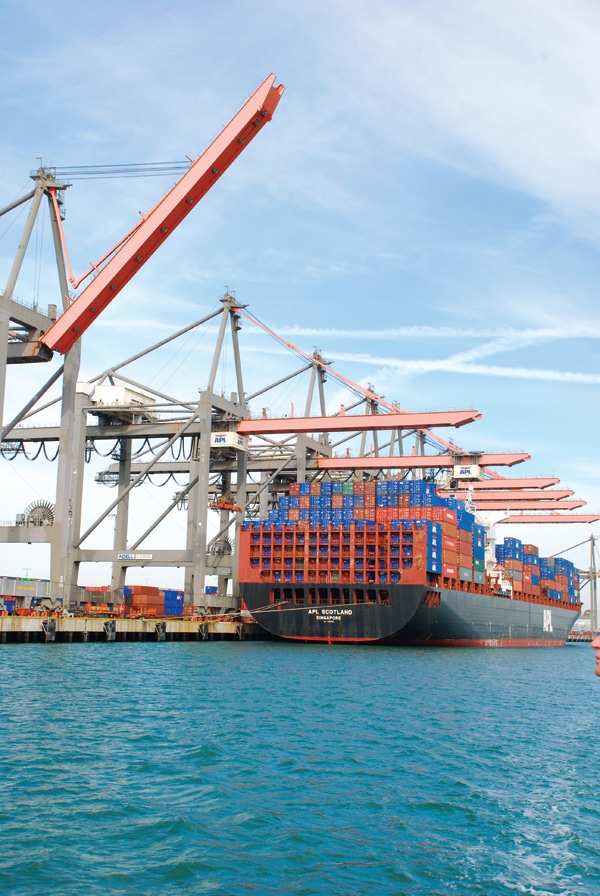September 1, 2011

Container shipping still handles only a small share of U.S. grain exports, but it’s proving its worth for transporting value-added grains, oilseeds and feed ingredients.
“It’s an option for the Asian market because the end user has specific qualifications for the cargo like No. 1 corn or bright yellow distillers’ dried grains (DDGs),” says Darrel McAlexander, a southwest Iowa farmer who has shipped white corn to South Korea.
“We could send small shipments to our customer in a 20-ft. container that holds about 780 bu. We were dealing with specialty markets, and thte customer couldn’t afford to take a hold in a Panamax ship” (the largest vessel size that can pass through the Panama Canal; usually holds about 55,000 mt of grain). “We couldn’t have accessed the market in any other way than the containers,” McAlexander explains.
Containers have been used for 30 years to ship grain in situations like McAlexander’s where preserving the shipment’s identity is essential. Their use has increased in the last seven years, not only for identity-preserved (IP) cargos, but for commodity grain.
Still, containers generally comprise less than 5% of the grain trade, in part because several factors determine whether a container shipment is economically viable.
Tom McKenna, who manages an IP corn program for Scoular Company, explains: “Where the steamship lines make their money is on the head haul (bringing goods to the U.S.), so they need their containers returned as soon as possible. On the back haul to Asia, they’ll take waste paper, scrap iron, or grains if possible, but the head haul drives the situation.”
Because a quick return is so important, containers are shipped back empty if no convenient backhaul cargo is available. That explains why containers are not readily shifted to serve markets like Mexico. The profits involved don’t sufficiently outweigh the cost of a delayed return.
Shipping commodity grains in containers “is a pure price issue,” says McKenna. “The bulk-grain business always wants to drive to the lowest cost. If the economics call for shipping grain ‘in a can,’ then you do it. Otherwise, the best way to export high volumes is bulk.”
There’s no way containers could handle the volumes that bulk does, says Bo DeLong of the DeLong Company, which exports soybeans and DDG in containers. Instead, he outlines how well containers work for IP and higher-value products.
“Containerized shipments offer the most direct access foreign buyers have with the American farmer,” DeLong says. “The product can go from the farmer to a single transloading location, and the next time it’s handled is when the customer receives it. It works for IP exports, and it helps maintain quality because there’s about five times less handling.”
Containers also work well for customers like McAlexander’s who can’t handle a full vessel load or full hold at one time.
McKenna cites two other situations when containers work well: just-in-time shipping and shipping to ports that can’t handle Panamax vessels. “We’re now seeing a lot of furniture coming by container from Vietnam, so it’s becoming a good place to send containerized grain. This market changes all the time.
“But containers can’t supply the world’s need for an ocean of grain,” he concludes.
When do containers work best?
So when do containers work best for the customer, where and how do they work well for the grower?
The real value is for farmers who are close enough to an active container yard to sell higher-value or IP commodities while spending less on transportation, according to McKenna. The biggest concentration of containers is around the top container ports – Los Angeles, Long Beach and San Francisco. In the heartland, Chicago and Kansas City dominate, and smaller yards are located in Omaha, St. Louis, Memphis, Peoria and Des Moines.
For farmers delivering to a company like DeLong, the process is similar to deliveries at a country elevator. DeLong transloads the crop into containers and delivers them to a rail terminal such as the huge warehousing district in Joliet, IL, where containers are shifted between storage, semi trailers and 110-car unit trains.
From there, containerized grain typically moves by rail to a major container port for export.
The alternative is for a commodity to travel by rail to the export terminal, where it’s then transferred to containers. For example, the Los Angeles Harbor Grain Terminal accepts containers loaded in the Midwest but also handles rail cars of corn, wheat, soybeans and DDGs. Similar logistics handling companies operate in ports like Seattle-Tacoma.
Container shipments, just 1% of all grain shipments in 2003, rose to 5% by 2009, according to estimates by Walter Kemmsies, chief economist for Moffatt & Nichol, then fell back to 3% in 2010.
More recently, containerized shipments of DDGS have fallen because of the Chinese DDGS anti-dumping case, expected to conclude by the year’s end.
If Chinese officials determine that DDGS have been dumped in China's market at prices below what other customers pay and that Chinese interests have been hurt, they could apply import tariffs on U.S. shipments, which have shot from about zero three years ago to more than 1.5 mmt last year. A decision on the case is expected by late December.
High soybean prices have shifted some shipments back into the lower-cost bulk market, according to USDA’s June 23 Grain Transportation Report.
In the longer term, Dwight Robinson, vice president of the Los Angeles Harbor Grain Terminal, warns of an issue that could undercut the
You May Also Like




